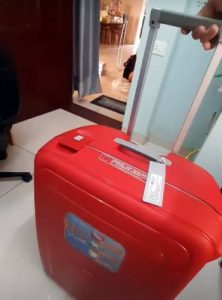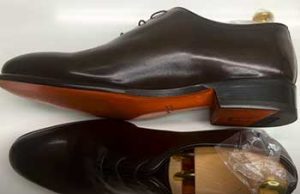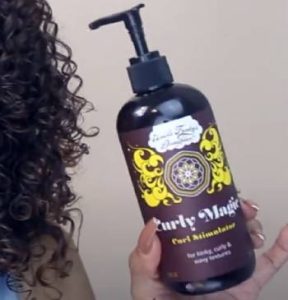Picture this: you’re trudging through wet, muddy fields, and your feet are dry, warm, and happy. That’s the magic of the Dive Bomb Trudge Boots, and I’m telling you, you need these in your life. Whether you’re tackling farm chores, walking the dog, or gearing up for a hunt, these boots are your ticket to comfort and convenience. I’ve been testing them out, and they’ve quickly become my go-to. Trust me, if you want rugged, practical footwear that doesn’t mess around, snag a pair. Let’s unpack my experience—warts and all—and see why these boots are worth it.
My First Steps with Dive Bomb Trudge Boots

I’ll admit, I was stoked when my Dive Bomb Trudge Boots arrived. Even the box got me hyped—those little duck logos? Too cool. I ripped it open, slipped them on, and headed out to my farm for a real-world test. It was a sub-zero morning, the kind that freezes your breath, and I had chores to do. Right away, I noticed how easy they were to slip on—well, mostly. My wide, flat feet gave me a bit of a wrestle at first, but once I yanked the back tab, they slid on snug. And that warmth? My toes stayed cozy despite the biting cold.
Since then, I’ve worn them everywhere—stomping through snowy woods, walking my pup on dewy grass, even quick trash runs. They’re lightweight enough that I don’t feel bogged down, and the heel lug? Genius. I kick them off hands-free every time. My wife and kids keep stealing them too, which says something—they’re a household hit! But let’s get real: they’re not flawless. I’ve got some thoughts, so stick with me as I break down the highs and lows.
How I Use the Dive Bomb Trudge Boots: Step-by-Step?
Wondering how these fit into daily life? Here’s my routine:
- Prep My Feet: I wear medium-thick socks—thin ones leave me chilly, too thick and it’s a squeeze.
- Slip Them On: Grab the back tab with one hand, front with the other, and tug. Wide feet mean a little shimmy, but they go on.
- Tackle the Day: Chores, dog walks, or muddy treks—I’m out there. The snug fit keeps me steady.
- Kick Them Off: Back home, I step on the heel lug with my other foot. Off they pop—no bending over.
- Clean Up: Muddy? I hose them down outside. Keeps the mess out of my house.
- Store Smart: I leave them by the door, upright, so they’re ready for the next round.
It’s simple once you get the hang of it. They’re my quick-grab boots for anything messy or cold.
Maintenance and How to Get the Most Out of Your Dive Bomb Trudge Boots

I want these boots to last, so I’ve dialed in a care routine. Here’s how I keep them kicking and how you can too:
- Rinse After Use: Mud’s their kryptonite. I blast them with a hose—focus on the tread—right after a messy day. Keeps gunk from hardening.
- Air Dry Only: No tossing them near a heater. I let them dry naturally, usually overnight, by the door. Stuff with newspaper if they’re soaked.
- Brush the Tough Stuff: Stuck-on dirt? A stiff brush and water work wonders. I avoid soap—don’t want to mess with the waterproofing.
- Store Upright: I keep them standing tall, not squashed in a pile. Helps the shape hold up and prevents creases.
- Check the Tabs: Those pull tabs take a beating. I tug gently to avoid ripping them—replaceable, but still a pain.
- Condition the Rubber: Every few months, I rub in a bit of silicone spray. Keeps the neoprene flexible and stops cracking.
- Wear Smart: I pair them with wool socks for extra warmth and cushion. Pro tip: rotate pairs if you’ve got another set—extends their life.
Treat them right, and they’ll stick with you through seasons of muck and cold. I’ve beaten mine up, and they’re still solid.
Pros and Cons of the Dive Bomb Trudge Boots
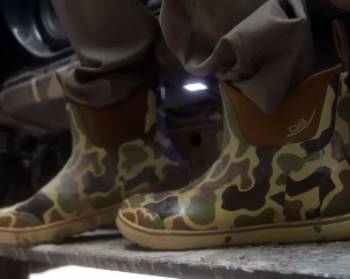
Pros:
Here’s what makes these boots a win in my book:
- Slip-On Ease: The wide mouth and heavy-duty pull tabs (front and back) make getting them on a breeze—once I figured out my wide-foot workaround.
- Hands-Free Removal: That heel lug is a game-changer. Step on it with your other foot, and boom—off they come. No muddy hands needed.
- Warmth That Delivers: In sub-zero temps, my feet stayed toasty. They’re not heavily insulated, but they trap heat just right for chilly mornings.
- Water Resistance: Wet grass, snow, muddy lots—no leaks here. My socks stay dry, and the tabs keep my pant legs out of the mess.
- Lightweight Feel: They don’t weigh me down like some clunky boots. I can wear them for hours without my legs screaming.
- Snug Fit: Once on, there’s no slop. My foot stays locked in, even when I’m slogging through uneven terrain.
- Rugged Style: They look sharp—my girlfriend’s jealous! That Dive Bomb logo on the heel pops, and the color options (I got Otter Brown) are slick.
Cons:
No rose-colored glasses here—there’s stuff I’d tweak:
- Wide-Foot Struggle: If your feet are broad like mine, slipping them on takes effort. They stretch over time, but it’s a hassle upfront.
- Sizing Quirk: I’m a 11.5-12, and the 12 fits—barely. Half-sizers, go up. They run a touch small, which threw me off at first.
- Mud Magnet Tread: The grippy soles are great on wet surfaces, but they hoard mud like a trophy. I’ve tracked dirt indoors more than once.
- Minimal Insulation: They’re warm enough for mild cold, but don’t expect toasty toes in a deep freeze without thick socks.
- Break-In Period: Out of the box, they felt stiff. Took a week of wear to mold to my feet—patience required.
- Not Boat-Proof: The tread’s slick on wet fiberglass. I nearly slipped launching my boat—stick to dry land or be cautious.
Dive Bomb Trudge Boots Vs. Other Brands
How do my Trudge Boots stack up? I’ve scoped out five competitors—here’s the rundown, 100 words each.
- Dive Bomb Trudge Boots Vs. Muck Boot Arctic Sport
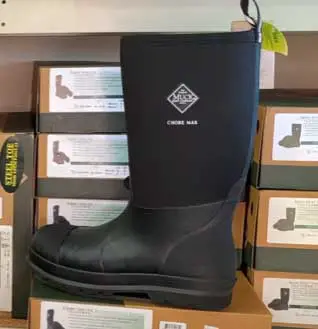
Muck’s Arctic Sport boots are tanks—built for serious cold with 5mm neoprene and fleece lining. I love my Trudge Boots’ lightweight vibe, but Muck’s insulation blows them out of the water for sub-zero marathons.
Trudge wins on slip-on ease; Muck’s a chore to wiggle into. Traction? Muck’s grippy, but mud sticks like glue—same as mine. Price-wise, Muck’s pricier ($150+ vs. $100ish).
I’d pick Trudge for quick tasks; Muck’s my go-to if I’m out in a blizzard all day. Style? Trudge looks cooler—Muck’s utilitarian.
- Dive Bomb Trudge Boots Vs. Xtratuf Ankle Deck Boot
Xtratuf’s Ankle Deck Boots scream fishing vibes—super waterproof with a non-slip sole that’s ace on wet decks. My Trudge Boots slip a bit on boats, so Xtratuf’s got the edge there. But Trudge’s heel lug beats Xtratuf’s basic pull-on design for removal. Both fit snug, though Xtratuf’s roomier for wide feet—less break-in needed. Trudge is lighter; Xtratuf feels chunkier. Price is close ($110 range), but Xtratuf’s durability feels tougher for hardcore use. I’d grab Trudge for chores, Xtratuf for docks or streams.
- Dive Bomb Trudge Boots Vs. Bogs Classic Mid
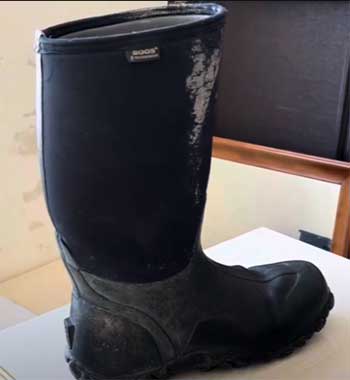
Bogs Classic Mid boots are cozy beasts—7mm neoprene, sub-zero rated, and cushy. My Trudge Boots can’t match that insulation; Bogs win for deep winter.
Trudge’s slip-on tabs and heel lug outshine Bogs’ basic design—easier on and off. Traction’s solid on both, but Bogs shed mud better. Trudge fits tighter; Bogs are roomier but sloppier.
At $120+, Bogs cost more, and they’re heavier. I love Trudge’s lightweight versatility for quick jobs; Bogs are overkill unless it’s a frozen tundra out there.
- Dive Bomb Trudge Boots Vs. LaCrosse Alpha Agility
LaCrosse Alpha Agility boots flex like sneakers—light, comfy, and waterproof. My Trudge Boots feel stiffer at first, needing break-in, but they’re just as light. LaCrosse’s tread grips better on slick surfaces; Trudge struggles on boats. Both slip on easy, though Trudge’s heel lug edges out LaCrosse’s pull loops. Insulation? Neither’s heavy-duty—Trudge keeps me warmer, oddly. LaCrosse runs $130ish, pricier than Trudge. I’d pick Trudge for rugged chores; LaCrosse if I’m hiking or need flexibility. Style’s a toss-up—both look sharp.
- Dive Bomb Trudge Boots Vs. Huk Rogue Wave
Huk Rogue Wave boots are fishing royalty—tall, grippy, and waterproof. My Trudge Boots are shorter, less boat-friendly, but way easier to kick off with that heel lug. Huk’s tread is insane on wet surfaces; Trudge slips more. Both fit true, though Huk’s roomier upfront. Trudge is lighter; Huk’s bulkier but tougher. At $120+, Huk’s pricier. I’d take Trudge for quick, muddy tasks—Huk’s overkill there. Huk shines on the water; Trudge stays land-based for me. Huk’s flashier—Trudge keeps it low-key cool.
Frequently Asked Questions (FAQs)
Not heavily—they’ve got neoprene and rubber, but no thick lining like 400-gram Thinsulate. I stay warm in sub-zero temps with good socks, but they’re not built for extreme cold. Fine for short bursts; layer up for longer.
Generally, yeah—depends on the sole. My Trudge Boots grip wet grass and mud decently, but slick boats? Not so much. True combat boots (think military-grade) often have deeper lugs for varied terrain—Trudge is more chore-focused.
SEALs rock specialized gear—often custom or brands like Bates, Danner, or lightweight water boots (e.g., Under Armour Valsetz). Trudge Boots? Not SEAL-grade—they’re too casual, lacking tactical heft or extreme water ops design.
Mine do—Trudge Boots block snow, mud, and wet grass like champs. Proper dive boots (for scuba or SEALs) are neoprene-heavy, sealing tighter. Trudge isn’t that intense but keeps me dry for land-based muck.
Final Thoughts
After pounding the pavement—or mud, rather—I’m sold on the Dive Bomb Trudge Boots. They’re not perfect, but for quick, messy jobs, they’re my MVPs. Lightweight, easy on-off, and dry feet? Check, check, check. You should grab a pair if you want practical, stylish boots that handle daily grind without breaking the bank. They’ve saved my socks and sanity—trust me, you’ll love them too. Get out there and trudge on!

